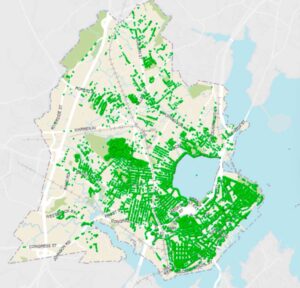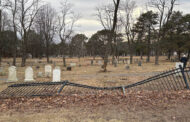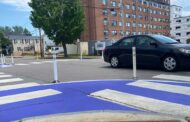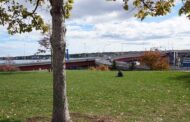
Liz Parsons & Roseanne Graef: Re-forest the Forest City
Every month PelotonLabs co-founder Liz Trice interviews a local community member. This month, Liz caught up with Liz Parsons and Rosanne Graef, members of the West End Neighborhood Association. They are working to expand Portland’s tree canopy and re-forest the Forest City.
How did you get interested in trees in Portland?
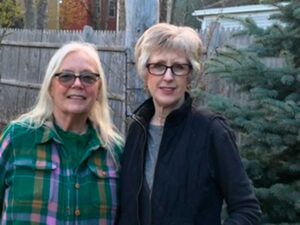
Roseanne: I grew up surrounded by trees on the outskirts of a very small town in Kennebec County. I love being among trees.
Liz P: I live near the former Mercy site, and there’s a lack of trees near hospitals, in part because of over salting during winter. A few years ago, a developer cut down several mature trees on a lot between Winter and State streets. Because the developer hadn’t submitted a site plan there was nothing in City code to prevent clear cutting. That got us to advocate for an ordinance. The Heritage Tree Ordinance provides limited protection to large trees in historic areas.
Why are trees so important?
Liz P: Street trees and urban forests help manage storm water surges, purify the air, sequester and store carbon, provide and connect habitat for wildlife, provide shade and coolness in summer, lowering the temperature up to 15 degrees. Trees reduce traffic speeds and provide safer walking environments, which in turn can provide more safety for residents and foot traffic for businesses. Trees absorb air pollution and make the air cleaner. The shade from trees extends the life of pavement by around 50%. Being around trees reduces blood pressure, improves overall emotional and psychological health, and has a calming and healing effect on ADHD adults and teens. Walking down a street with trees is pleasant. Trees make us happy and healthy! There’s even evidence that trees reduce road rage!
Why are trees an equity issue?
Liz P: A map from American Forest shows the city’s overall tree canopy coverage and breaks it down by census tract. The majority Black census tract in Bayside behind City Hall has the least tree canopy in the district. The City Council allocated $250,000 to try to close this equity gap, and it looks like the tree equity project will get some more funding from CDBG this year.
A group of us have been advocating for more tree planting, more forestry staff, and a more protective tree ordinance that covers the whole city. In the 19th century, Portland used to have a very strong tree ordinance that prescribed a large fine and jail time for persons injuring city trees (wow!). And in the 1970s, the forestry department had thirty staff and was planting thousands of trees each year.
In the years since, repeated budget cuts have decimated the department. Now the department has five staff and is lucky if they can plant 200 trees a year, which is fewer than the amount being cut each year. Further, many of those saplings die because the department does not have the staff to do sustained watering that trees need to survive.
What does it take to keep a new tree alive?
Rosanne: New trees need 15-20 gallons of water every week during the summer for the first year, and the second and third year, every few weeks. Tree bags are helpful because you can fill up the bag and walk away, or you can bring water via buckets or wheelbarrow. Tree bags help keep the water contained and not running off into the street.
What efforts are underway currently?
Liz P: We have collaborated with several experts on ways to strengthen and expand the Heritage Tree Ordinance and are advocating for this with City officials.
Rosanne: Herb Adams did a street tree inventory for the Parkside area. We then organized a street tree inventory for the West End bounded by the Western Prom, Commercial, High, and Congress streets. Volunteers went street by street counting trees and noted whether they were healthy or unhealthy, if there is a stump, if there’s an empty tree well.
What would the Re-forest the City pilot neighborhood association program do?
Rosanne: The idea is to collaborate with the Parkside, St. John/Valley Street, West End, and Western Promenade neighborhood associations to address the crucial role trees play in making urban neighborhoods livable and healthy. The objectives would be to increase the number of trees planted particularly in public areas such as along streets, increase the survivability rate of street trees on the peninsula, and increase the peninsula’s overall tree equity score.
We plan to work with neighborhood groups and the City to inventory street trees in peninsula neighborhoods contiguous to MMC, identify unhealthy and/or mutilated trees that the city arborist should evaluate for longevity and/or replacement, identify specific neighborhood areas lacking street trees so that neighborhood associations can advocate for new tree installments, and help neighborhood associations recruit tree adopters to water and monitor the health of new saplings. We’d also like to offer public events about the historical elements of the peninsula tree canopy, links between tree coverage and public health, and tree identification and care.
How To Get Involved / Learn More
Herb Adams will be giving a talk on May 18th – Portland’s Trees: Today, Yesterday, Tomorrow. For more information visit www.wenamaine.org.
Explore Portland’s online Tree Map: https://portlandme.maps.arcgis.com/apps/webappviewer/index.html?id=8c1f329f45384c1080608df88501bcbe

